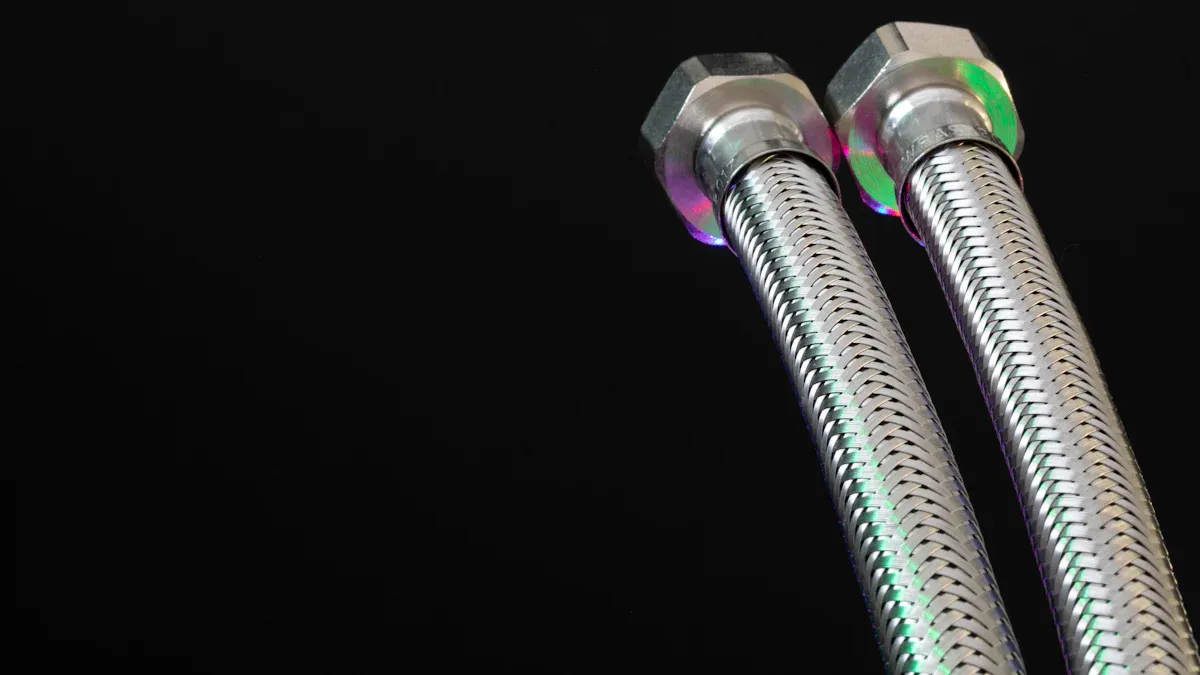
High-pressure environments demand reliable components. 316L stainless steel hose fittings stand out as a premier choice. These fittings, particularly those with JIC 37-degree flare, SAE Code 61/62 flange, or NPT/BSPT tapered thread connections, deliver exceptional performance. They boast superior corrosion resistance and impressive strength. Furthermore, a secure sealing mechanism is a critical advantage. This makes them perfectly suited for the most demanding applications. Selecting the correct Stainless Steel Pipe Fitting ensures system integrity. Engineers seek a robust Stainless Steel Fitting that performs under stress. Many professionals rely on these durable Stainless Steel Fittings. High-pressure systems consistently benefit from quality Stainless Steel Pipe Fittings.
Key Takeaways
- Choose 316L stainless steel for hose fittings. It works best in high-pressure and harsh conditions. This material resists rust and stays strong.
- Pick the right connection type for safety. JIC 37-degree flare, SAE Code 61/62 flange, and ORFS connections are good choices. They stop leaks and handle strong forces.
- Understand pressure ratings. Working pressure is safe for daily use. Burst pressure is when a fitting breaks. The burst pressure should be four times higher than the working pressure for safety.
- Install fittings correctly and keep them clean. This makes them last longer. Always follow instructions to avoid leaks and damage.
Understanding High-Pressure Demands on Stainless Steel Hose Fittings
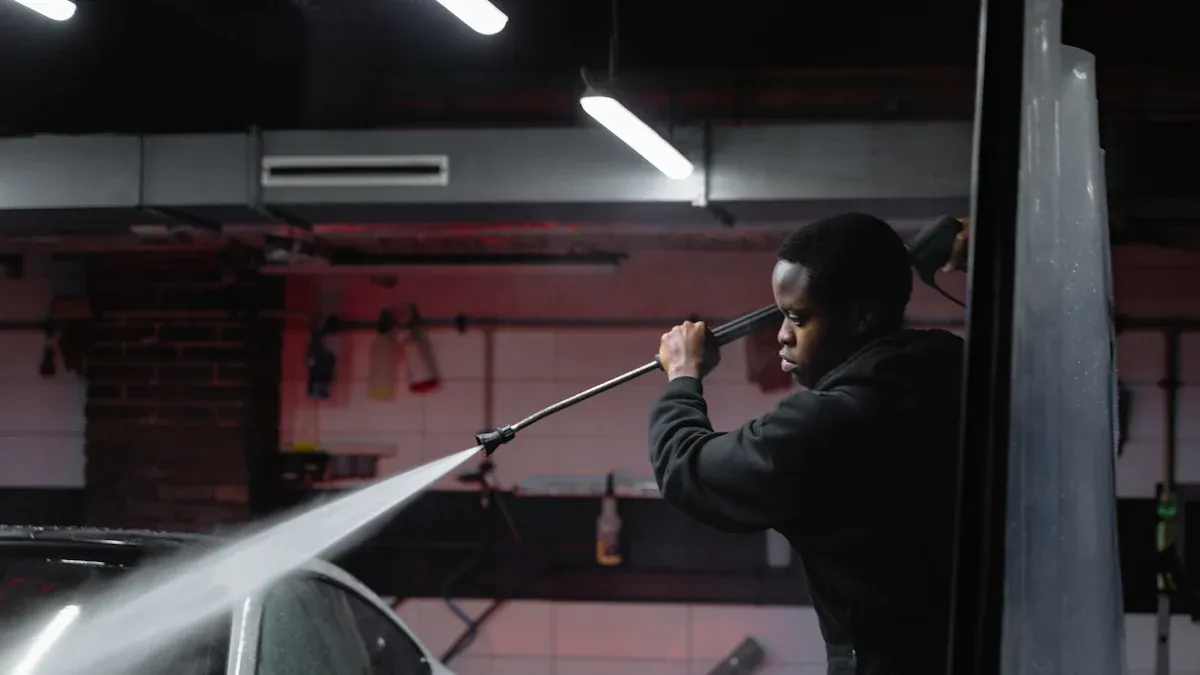
Defining High-Pressure in Industrial Applications
What exactly does “high-pressure” mean in industrial settings? It is more than just a feeling of intense force. In hydraulic systems, engineers consider pressures above 1000 psi (70 bar) as high-pressure. These systems often reach several thousand psi. Some demanding applications even push past 20,000 psi, with extreme cases hitting up to 58,000 psi. These numbers show the immense forces at play.
Why Standard Fittings Fail Under High Pressure
Standard fittings simply cannot handle such extreme conditions. They often fail due to several factors. Environmental issues like extreme temperatures, UV exposure, or chemical contact can degrade materials. For example, heat causes softening, while cold makes materials brittle. Improper installation also plays a big role; over-tightening damages threads, and under-tightening leads to loose connections. Wear and tear from abrasion or mechanical damage, like bending beyond limits, also weakens fittings. Most critically, excessive pressure causes bulging, cracking, or bursting. Pulsation and mechanical stress further fatigue the materials. Even contamination from dirt or degraded fluid can cause abrasive wear and chemical degradation, leading to leaks and failures.
Advantages of Stainless Steel for High-Pressure Applications
Stainless steel offers significant benefits for high-pressure systems. Its mechanical properties make it incredibly strong. It boasts high yield strength, meaning it resists permanent deformation under stress. Its tensile strength allows it to withstand maximum stress before breaking. The crystalline structure of stainless steel also permits significant deformation without failure, maintaining structural integrity. Specialized heat treatments, like precipitation hardening, further enhance its strength, especially at high temperatures. Beyond strength, stainless steel provides superior corrosion resistance. Its chromium content creates a self-healing passive layer on the surface. This layer continuously protects against rust and oxidation, even if damaged. This feature is vital for systems handling corrosive substances, ensuring long-term performance and reducing maintenance needs. These qualities make Stainless Steel Hose Fittings a reliable choice.
Key Stainless Steel Alloys for High-Pressure Hose Fittings
Choosing the right stainless steel alloy is a big decision for high-pressure systems. Different alloys offer unique strengths. They perform best in specific conditions. Let’s explore the top contenders.
316L Stainless Steel for High Pressure and Corrosive Environments
Many experts consider 316L stainless steel a top choice for demanding high-pressure and corrosive environments. Its special composition makes it very strong and resistant to rust. The “L” in 316L stands for “low carbon.” This lower carbon content is a key feature. It helps prevent a problem called sensitization during welding. Sensitization can make the steel more vulnerable to corrosion near the weld areas.
Here is a look at the main chemical differences between 316 and 316L stainless steel:
| Element | 316 (UNS S31600) | 316L (UNS S31603) |
|---|---|---|
| Carbon (C) | ≤ 0.08% | ≤ 0.03% |
| Silicon (Si) | ≤ 1.00% | ≤ 1.00% |
| Manganese (Mn) | ≤ 2.00% | ≤ 2.00% |
| Phosphorus (P) | ≤ 0.045% | ≤ 0.045% |
| Sulfur (S) | ≤ 0.030% | ≤ 0.030% |
| Nickel (Ni) | 10.0-14.0% | 10.0-14.0% |
| Chromium (Cr) | 16.0-18.0% | 16.0-18.0% |
| Molybdenum (Mo) | 2.0-3.0% | 2.0-3.0% |
You can see that 316L has a maximum carbon content of just 0.03%. Standard 316 stainless steel allows up to 0.08% carbon. Both grades contain similar amounts of chromium, nickel, and molybdenum. The molybdenum content, typically between 2-3%, gives 316L its excellent resistance to pitting and crevice corrosion. This is especially important in environments with chlorides, like saltwater or certain chemicals.
For some specific types of fittings, like 316L Stainless Steel Push-In Fittings, the maximum operating pressure is around 30 bar (435 psi). However, the overall pressure capability of 316L fittings varies greatly. It depends on the specific design and connection type. Many high-pressure Stainless Steel Hose Fittings use 316L for its robust performance.
304/304L Stainless Steel Suitability for High Pressure
While 316L often gets the spotlight, 304 and 304L stainless steel also play a vital role in high-pressure applications. These alloys are very common. They offer a good balance of strength, corrosion resistance, and cost-effectiveness. 304L, like 316L, has a lower carbon content than its 304 counterpart. This makes it better for welding.
304L flanges, for example, are excellent for high-pressure uses. They offer inherent strength, flexibility, and toughness. Industries widely use them in many high-pressure settings. These include:
- Chemical and petrochemical processing
- Power generation
- Oil and gas refineries
- General plumbing systems
- Pressure vessels
- Piping systems
- Petroleum refining
304/304L stainless steel provides robust and durable connections. These connections can handle high pressure and temperature conditions. While it may not offer the same level of corrosion resistance as 316L in highly aggressive environments, it performs very well in many high-pressure scenarios. These qualities make 304/304L a strong contender for many Stainless Steel Hose Fittings in high-pressure systems.
Specialty Alloys for Extreme Pressure Stainless Steel Hose Fittings
Sometimes, even 316L stainless steel is not enough. For the most extreme pressure and temperature conditions, engineers turn to specialty alloys. These materials offer enhanced properties. They push the boundaries of what is possible.
These superalloys have several key advantages:
- Exceptional High-Temperature Performance: Superalloys keep their structure and function at temperatures above 1600°C. This far surpasses what conventional metals can handle.
- High Strength and Creep Resistance: These alloys show remarkable strength even at high temperatures. They resist creep, which is deformation under constant stress. This is crucial for components in very demanding conditions.
You find these high-strength steel alloys in critical applications. They are used for missile bodies, where they withstand immense internal pressure and external forces during launch and flight. They also construct pressure vessels in aerospace vehicles. These vessels need to handle high internal pressure safely. When the stakes are highest, specialty alloys deliver the performance needed.
Ideal Connection Types for High-Pressure Stainless Steel Hose Fittings
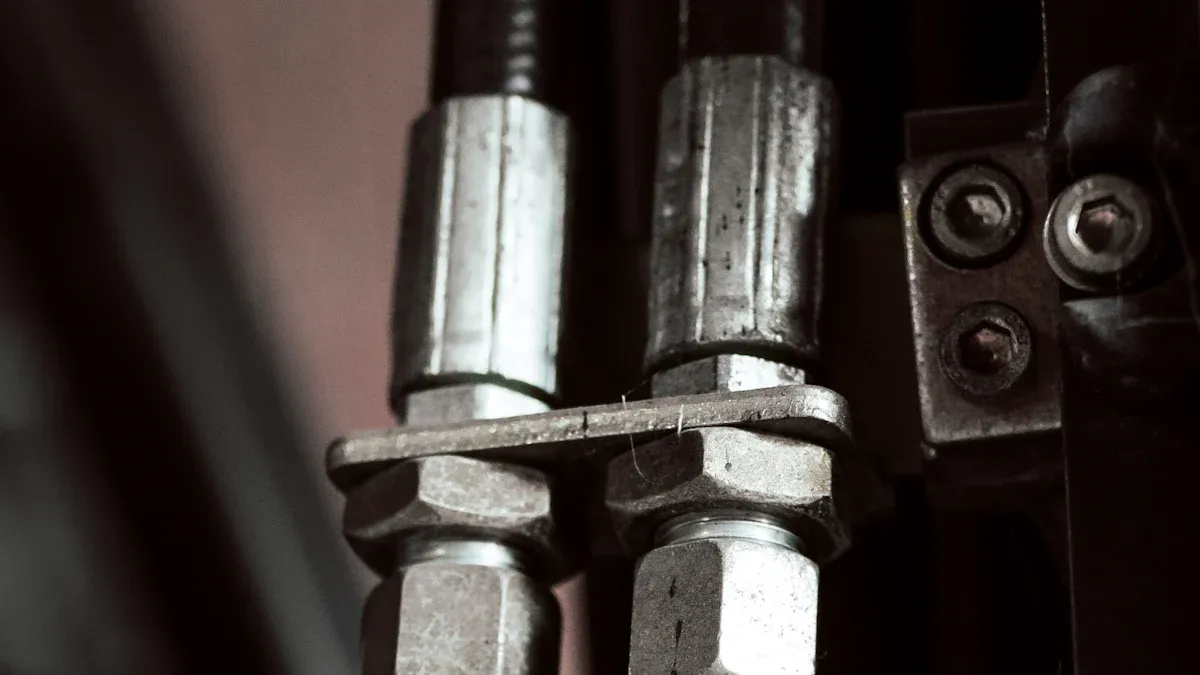
Choosing the right connection type is just as important as selecting the correct alloy for high-pressure applications. The connection ensures a secure, leak-free seal. Different designs offer unique benefits for various high-pressure scenarios. Let’s explore the most effective connection types for high-pressure systems.
JIC 37-Degree Flare Stainless Steel Hose Fittings
JIC 37-degree flare fittings are a popular choice in hydraulic systems. They provide a reliable metal-to-metal seal. This design makes them highly effective for high-pressure applications. The 37-degree flare angle helps create a strong connection. It minimizes the risk of leaks.
These fittings offer great versatility. You can use them in many hydraulic applications. This includes machinery, construction equipment, and automotive systems. They are also very durable. Manufacturers make them from premium materials. This helps them withstand high pressures, extreme temperatures, and harsh operating conditions. Installation is also straightforward. The flare angle makes assembly easy. You can often use hand tools or a flare nut wrench. The metal-to-metal seal prevents fluid leakage. This keeps the system safe and working correctly. JIC fittings handle high-pressure applications well. They provide a secure connection even in tough conditions. Their superior sealing capabilities reduce leaks and fluid loss. They work with many fluids, like hydraulic oils, fuels, and water-based fluids. This makes them very adaptable. They are also easy to install and maintain. This saves time during assembly and maintenance. Their strong build ensures long-lasting performance. This means fewer replacements.
JIC 37-degree flare fittings have impressive pressure ratings. These ratings follow SAE J514 standards. They base the working pressure on a 4:1 design factor for minimum burst pressure. These are dynamic pressure ratings. This means the fittings can pass a cyclic endurance test. They endure one million cycles at 133% of their working pressure. Stainless steel JIC 37-degree flare fittings can handle pressures up to 430 bar. They are rated up to 6,000 PSI. These fittings meet SAE J514 and ISO 8434-2 standards. Working pressures for JIC 37-degree flare fittings can reach 5000 PSI. However, the actual working pressure depends on the specific tube and fitting size.
The table below shows typical working pressure ratings for various JIC 37-degree flare fittings:
| Tube OD (Inch) | Unions/Bulkhead (psig) | Pipe Threads (psig) | Female Swivel (psig) |
|---|---|---|---|
| 1/4 | 5000 | 5000 | 4500 |
| 5/16 | 5000 | 5000 | 4000 |
| 3/8 | 5000 | 4000 | 4000 |
| 1/2 | 4500 | 3000 | 4000 |
| 5/8 | 3500 | 3000 | 3000 |
| 3/4 | 3500 | 2500 | 3000 |
| 1 | 3000 | 2000 | 2500 |
| 1 1/4 | 2500 | 1150 | 2000 |
| 1 1/2 | 2000 | 1000 | 1500 |
| 2 | 1500 | 1000 | 1125 |
These working pressure ratings follow SAE J514 standards. They meet a minimum burst pressure ratio of 4:1.
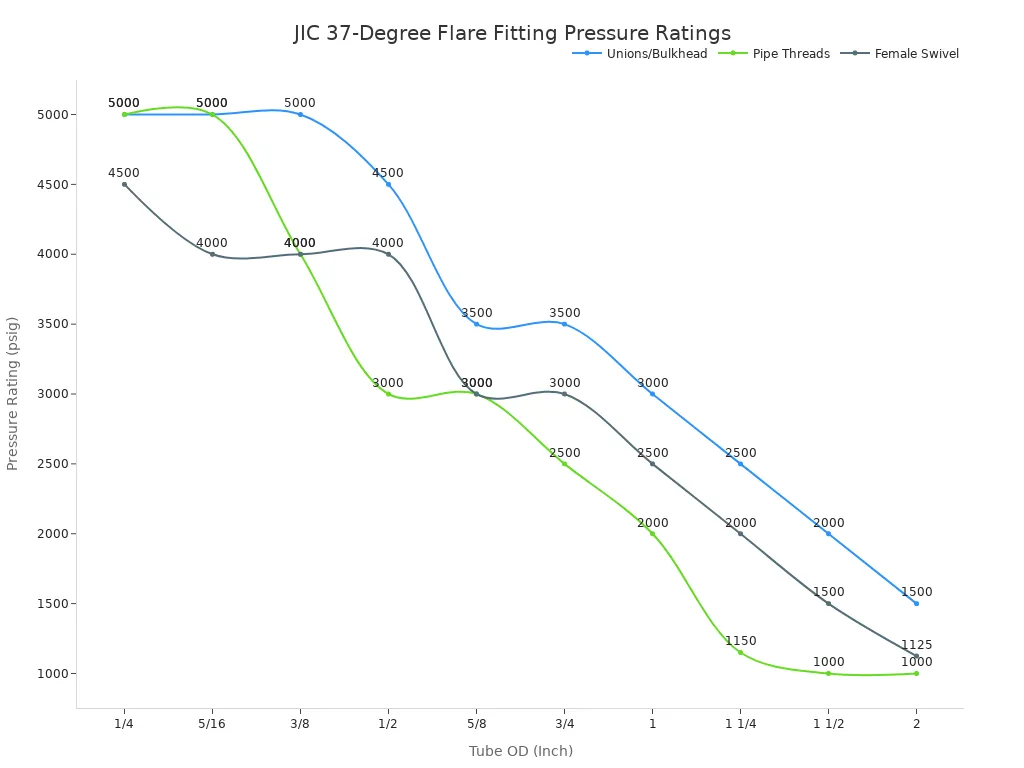
SAE Code 61/62 Flange Stainless Steel Hose Fittings
SAE flange connections are another excellent choice for high-pressure applications. They are especially useful in situations with high operating pressures. They also withstand significant shocks and vibrations in hydraulic systems. These flanges are great for installation in tight spaces. This is true, especially for larger sizes. Their four-bolt design helps distribute tightening forces evenly. This makes them a reliable alternative. You use them when regular tube fittings are not allowed or not practical. This can happen due to pressure, size, or limited mounting space. SAE flanges offer much higher pressure resistance for most sizes. The 6,000 PSI High-Pressure Series can resist up to 400 bar. You find them in industrial hydraulics, mobile hydraulics, and shipbuilding. SAE flange adapter fittings meet SAE J518 code 61 (3000 psi) and code 62 (6000 psi) for high-pressure hydraulic applications. They provide a leak-free connection. This makes them suitable for high pressures, larger sizes, and assembly in tight quarters. The 4-bolt hydraulic SAE flange connection follows SAE J518 and ISO 6162 standards.
SAE Code 61 flanges are also known as SAE 3000 flanges. They have a maximum working pressure of class 3000 psi. Their working pressure ranges from 35 bar to 350 bar. This depends on the flange size and the bolt grade. SAE Code 62 flanges are also called SAE 6000 flanges. They have a maximum working pressure of class 6000 psi, which is 420 bar.
Here is a quick look at their pressure classifications:
| Flange Type | Pressure Rating (PSI) | Pressure Rating (bar) |
|---|---|---|
| Code 61 | 500 – 5000 | 35 – 350 |
| Code 62 | Up to 6,000 | Up to 420 |
NPT/BSPT Tapered Thread Stainless Steel Hose Fittings
NPT (National Pipe Taper) and BSPT (British Standard Pipe Taper) tapered thread fittings are common in many high-pressure systems. These fittings create a seal by deforming the threads. As you tighten the fitting, the tapered threads wedge together. This forms a mechanical seal. You often use a thread sealant or tape with these connections. This helps ensure a leak-free joint.
NPT and BSPT fittings are widely available. They are also relatively easy to install. However, they rely on thread deformation for sealing. This means they might not be as suitable for applications with extreme vibration or frequent disassembly. For very high-pressure applications, engineers often prefer JIC or SAE flange connections. These offer more robust sealing mechanisms. Still, for many high-pressure fluid transfer lines, NPT and BSPT fittings provide a cost-effective and reliable solution. They are particularly useful in plumbing and process piping where a permanent or semi-permanent connection is needed.
O-Ring Face Seal (ORFS) Stainless Steel Hose Fittings
O-Ring Face Seal (ORFS) fittings offer another excellent solution for high-pressure applications. These fittings excel at preventing leaks, even in demanding conditions. They achieve this through a clever design. An O-ring, often made from Buna-N or Viton (90 Durometer), sits in a groove on the fitting’s face. When you tighten the connection, this O-ring compresses between the fitting’s O-ring face and the flat face of a mating ORFS fitting or formed tube. This compression creates an elastomeric seal.
Stainless Steel ORFS adapters are specifically engineered for high-pressure and high-vibration hydraulic systems. They provide reliable, leak-proof connections. Their design also makes assembly and disassembly easy, which streamlines maintenance. These fittings also prevent over-tightening, reducing the risk of component damage during installation. This combination of features ensures their effectiveness in preventing leakage under demanding conditions. ORFS fittings prevent leakage in high-pressure stainless Steel Hose Fittings by utilizing an O-ring, typically Buna-N, housed in a precision-machined groove within the fitting body. The seal forms when the tailpiece, fixed to the tubing, compresses this O-ring against the face of the threaded fitting body as the nut tightens. This compression ensures a tight seal for fluids and gases, even at very high pressures and vacuum. The design also incorporates materials like Type 316 stainless steel for bodies and nuts, and Type 316L for sleeves/tailpieces, contributing to their robustness in high-pressure applications.
ORFS fittings come in various configurations to suit different needs:
- Stainless Steel ORFS Braze Sleeve
- Stainless Steel SAE O-Ring Face Seal ORFS Male x 37° Male JIC Adapter
- Stainless Steel SAE O-Ring Face Seal ORFS Male x SAE O-Ring Face Seal ORFS Female Swivel 90° Elbow
- Stainless Steel SAE O-Ring Face Seal ORFS Swivel Nut Branch Tee
- Stainless Steel SAE O-Ring Face Seal ORFS Swivel Nut Run Tee
- Stainless Steel Male ORFS x Male ORB Adjustable 90° Elbow
- Stainless Steel Male ORFS x Male ORB 90° Elbow Long
These fittings boast impressive pressure ratings. The table below shows typical maximum working pressures for various ORFS fittings.
| Dash Size | Nominal Tube/Port Size | O-Ring Face Seal (ORFS) SAE J1453 Fixed (psi) | O-Ring Face Seal (ORFS) SAE J1453 Adjustable (psi) |
|---|---|---|---|
| -4 | 1/4″ | 6000 | 6000 |
| -5 | 5/16″ | 6000 | 6000 |
| -6 | 3/8″ | 6000 | 6000 |
| -8 | 1/2″ | 6000 | 6000 |
| -10 | 5/8″ | 6000 | 6000 |
| -12 | 3/4″ | 6000 | 6000 |
| -14 | 7/8″ | 6000 | 6000 |
| -16 | 1″ | 6000 | 5000 |
| -20 | 1-1/4″ | 4000 | 4000 |
| -24 | 1-1/2″ | 4000 | 3000 |
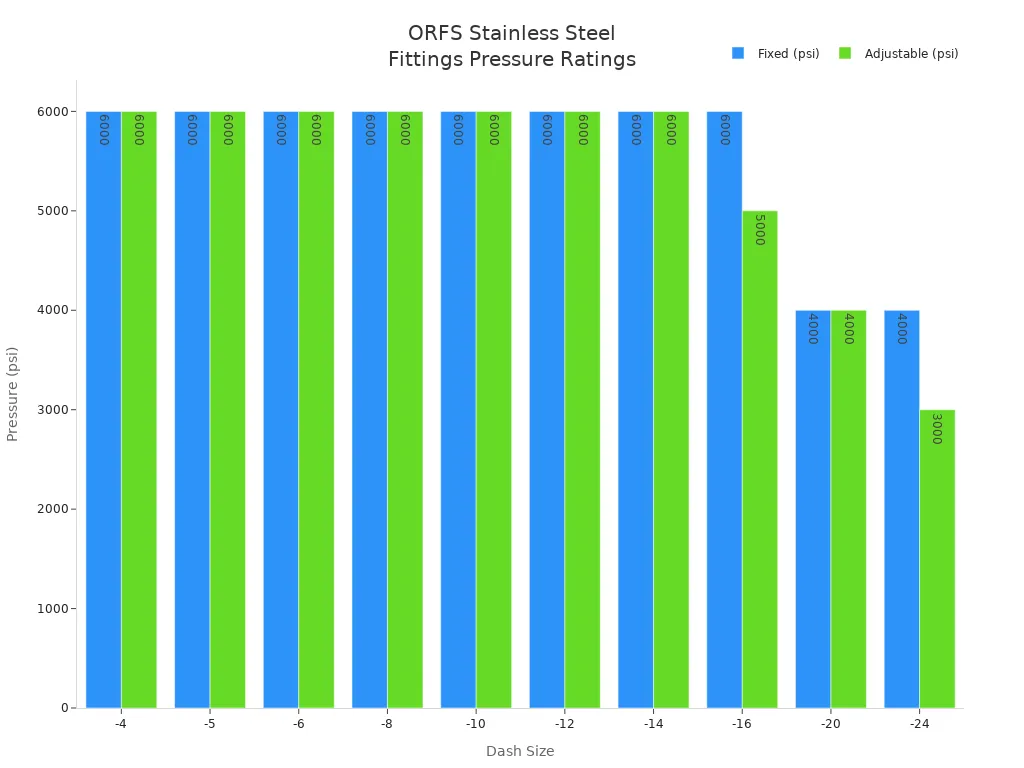
These recommended maximum working pressures come from limited laboratory test data. They serve as approximate guidelines, based on a 4:1 safety factor relative to the connection minimum burst pressure. Testing occurred at SAE recommended assembly torque in hardened test blocks. The maximum pressure for any adapter or tube fitting must be the lower of the chosen mating end types. Engineers must adjust pressure ratings for any change in adapter material. All pressure ratings appear in pounds per square inch (psi).
Welded Connections for Critical High-Pressure Systems
For the most critical high-pressure systems, especially those requiring absolute integrity and permanence, welded connections often become the preferred choice. These connections offer unparalleled strength and reliability.
Welded connections provide several key advantages:
- They are robust and resilient in harsh environments.
- Smooth inner surfaces and gradual directional changes ensure seamless flow and minimize pressure drops.
- They offer various turn radii options, allowing for smoother changes in flow direction.
- They boast a long service life and superior resistance to corrosion and erosion.
However, welded connections also present some disadvantages:
- They involve higher cost and complexity due to welding requirements.
- The installation process is time-consuming.
- They have strict fit-up requirements for proper alignment.
- They are sensitive to weld quality, requiring skilled welders.
Let’s compare welded connections with mechanical fittings like threaded ones:
| Feature | Welded Connections | Mechanical Fittings (Threaded) |
|---|---|---|
| Advantages | - Permanent, strong connection | - Easier and faster to install |
| - Ideal for high-pressure/temperature environments | - No special tools or skills needed | |
| - Reduces risk of leakage | - Easy to disassemble for maintenance/modifications | |
| Disadvantages | - Requires skilled labor (welding expertise) | - More prone to leaks, especially in high-pressure systems |
| - Time-consuming installation | - Less durable in high-stress environments | |
| - Difficult to modify or disassemble | - Threads may become damaged over time | |
| Strength | Very strong, leak-proof bond; fuses materials | Strong, but less robust; typically for lower-pressure |
| Applications | Oil & gas, chemical processing, power plants (high-pressure/temperature) | Plumbing, residential, low-pressure industrial (disassembly needed) |
Critical Factors for Selecting High-Pressure Stainless Steel Hose Fittings
Choosing the right fittings for high-pressure systems involves more than just picking a strong material. Several critical factors influence the safety and longevity of your setup. You must consider each one carefully to ensure optimal performance.
Pressure Rating vs. Burst Pressure for Stainless Steel Hose Fittings
Understanding pressure ratings is crucial. Working pressure is the maximum pressure a fitting can safely handle during normal operation. Burst pressure, however, is the point at which the fitting will physically fail. The industry standard safety factor between working pressure and burst pressure for high-pressure hose fittings and hoses is 4:1. This means the burst pressure should be at least four times greater than the working pressure. For example, if a system operates at 3,000 psi, the fittings must withstand at least 12,000 psi before bursting. While 4:1 is a common industry standard, safety factor values in hydraulic applications can range from 3 to 4 or higher. This depends on how critical the system is and how much operating conditions vary. A safety factor of 4 generally works well for standard applications, giving a strong buffer against most unexpected operational issues.
Temperature Range Considerations for Stainless Steel Hose Fittings
Temperature significantly impacts fitting performance. Extreme heat or cold can weaken materials and reduce pressure ratings. Stainless steel fittings show superior performance over brass in both extreme temperature and pressure conditions. They handle higher temperatures and pressures more effectively, making them suitable for demanding industrial applications.
Here is a look at how different materials handle heat:
| Material Type | Intermittent Temperature Threshold |
|---|---|
| 304 Stainless Steel | Up to 1,600°F (871°C) |
| 316 Stainless Steel | Up to 1,650°F (899°C) |
| Carbon Steel | Lower than stainless steel (becomes brittle) |
| Brass | Lower than stainless steel (degrades faster) |
Always check the manufacturer’s specifications for the exact temperature limits of your chosen fittings.
Media Compatibility with Stainless Steel Hose Fittings
The fluid or gas flowing through your system directly interacts with the fitting material. This means media compatibility is vital. Certain chemicals can corrode or degrade stainless steel over time, even high-grade alloys. For instance, chlorides can cause pitting corrosion in some stainless steels. Always verify that the fitting material can withstand the specific media it will transport. This prevents premature failure and maintains system integrity.
Vibration and Pulsation Resistance of Stainless Steel Hose Fittings
High-pressure systems often experience significant vibration and pulsation. These forces can quickly wear down fittings and lead to leaks or failures. Therefore, fittings must resist these dynamic stresses. Some designs specifically address this challenge. For example, the Convoluted Transfer Hose features uniquely designed PTFE helical low-profile convolutions. It also includes multi-layers of fiberglass and stainless steel braid. This construction creates a very flexible hose. It offers excellent absorption of vibration in dynamic connections. It also provides optimal static and pulsating resistance under temperature and pressure.
Manufacturers design many fittings with anti-vibration features. Here are some examples:
| Series/Product | Type | Feature |
|---|---|---|
| HCB | Pneumatic fitting | Vibration-resistant |
| 21AVA4M series | Hydraulic fitting | Anti-vibration |
| 65AV series | Hydraulic fitting | Anti-vibration |
| 152 series | Hydraulic fitting | Anti-vibration |
| Stäubli HPX quick-release coupling range | Hydraulic fitting | Designed for pulsating or vibrating flow, robust screw locking mechanism |
These specialized designs ensure the integrity of the system even under constant movement and pressure fluctuations.
Installation and Maintenance of High-Pressure Stainless Steel Hose Fittings
Proper installation and regular maintenance are crucial for the longevity and safety of high-pressure Stainless Steel Hose Fittings. Incorrect installation can lead to premature failure, even with the best components.
Here are some best practices for installation:
- Correct Installation: Install fittings properly. Align all components. Tighten them to the manufacturer-specified torque. This prevents leaks and damage.
- Don’t Over-pressurize: Operate within the fitting’s maximum pressure rating. This avoids ruptured hoses or failed fittings. Use fittings rated for expected pressures. Monitor system pressure frequently.
- Keep the System and Components Clean: Prevent contaminants like dirt, dust, and debris from damaging components. Ensure hydraulic fluid is filtered. Do not introduce contaminants during installation or maintenance.
- Monitor Fluid Levels and Quality: Regularly check fluid levels and quality. Poor or contaminated fluid can cause excessive wear on hoses and fittings. This leads to early failure.
Securing hoses properly also prevents issues:
- Position Clamps Strategically: Place clamps at regular intervals. Avoid areas too close to hose ends. This prevents undue stress on fittings.
- Use the Right Size Clamps: Ensure clamp size matches hose diameter for a secure fit. Too tight can damage, too loose can slip.
- Install Sleeves Correctly: Use correct length sleeves. Fit them properly over the hose. Extend them past potential abrasion points. Attach them securely.
- Ensure Proper Support: Use brackets or hangers to prevent sagging. Ensure they do not interfere with hose movement or create stress points.
Avoiding common installation errors is also vital:
- Accurate Measurement: Measure hose length carefully. Add a small amount of slack (5-10%) for movement without overextending.
- Adhere to Bend Radius Specifications: Always check and follow the manufacturer’s recommended minimum bend radius. Use angled fittings or elbows for tight bends.
- Avoid Twisting During Installation: Mark hose orientation and maintain it. Use swivel fittings if rotation is necessary.
- Secure the Hose Properly: Use clamps, brackets, and supports at regular intervals. Ensure they hold firmly without pinching.
- Select the Right Fittings: Verify fittings are compatible with hose type, pressure rating, and fluid. Follow manufacturer recommendations for leak-free connections.
- Consider Environmental Factors: Choose hose material suitable for temperature, chemical exposure, and abrasion. Add protective sleeves if needed.
For enhanced reliability, consider these advanced practices:
- Account for Thermal Cycling: Use spring clamps or self-adjusting clamps. They maintain tension during thermal expansion and contraction. Ensure clamp selection accommodates the full temperature range.
- Upgrade to Higher Quality Materials: If clamp failure is common, switch to higher-grade materials like 316 stainless steel. This offers superior corrosion resistance, especially in marine or chemical applications.
- Apply Sealants or Lubricants Wisely: Use compatible sealants or anti-seize lubricants in high-pressure or high-temperature scenarios. Ensure they do not degrade hose or clamp materials.
- Ensure Proper Fit Between Hose and Fitting: Verify the hose’s internal diameter matches the fitting’s outer diameter. The clamp must be the correct size for both. This prevents leaks, slippage, or clamp deformation.
- Torque Wrenches for Consistent Tightening: Use a torque wrench to tighten hose clamps to manufacturer-recommended specifications. This is especially important in pressurized systems. It prevents over- or under-tightening.
Future Trends in High-Pressure Stainless Steel Hose Fittings (2025 Outlook)
The world of high-pressure systems constantly evolves. Manufacturers look for new ways to improve safety and performance. Several exciting trends will shape the future of Stainless Steel Hose Fittings.
Advanced Manufacturing Techniques for Stainless Steel Hose Fittings
New manufacturing methods will change how companies make high-pressure Stainless Steel Hose Fittings. Additive manufacturing, also known as 3D printing, offers great promise. This technology allows engineers to create complex shapes. They can design parts with internal channels or unique geometries. This leads to stronger fittings. It also reduces material waste. Advanced machining processes will also improve precision. These methods ensure tighter tolerances. This results in more reliable seals. These innovations will make fittings even more robust for extreme conditions.
Smart Stainless Steel Hose Fittings for Pressure Monitoring
The future will bring “smart” fittings. These fittings will have integrated sensors. These sensors can monitor pressure in real-time. They will detect changes or drops in pressure immediately. This helps prevent failures before they happen. Some sensors might also track temperature or vibration. They can send data wirelessly to a central system. This allows for proactive maintenance. It also improves overall system safety. Operators will receive alerts on their devices. This gives them instant information about system health.
Sustainability and Material Innovations in Stainless Steel Hose Fittings
Sustainability is becoming very important. Future trends will focus on eco-friendly practices. Manufacturers will explore new, more sustainable stainless steel alloys. These alloys might use recycled content. They could also require less energy to produce. Production processes will also become greener. Companies will aim to reduce waste and energy consumption. Innovations in material science will also lead to even stronger and lighter fittings. These new materials will offer better performance with less environmental impact.
Prioritizing 316L stainless steel and robust connection types like JIC 37-degree flare, SAE Code 61/62 flange, or ORFS is crucial for high-pressure Stainless Steel Hose Fittings. These choices ensure system strength and reliability. Careful consideration of pressure ratings, temperature, and media compatibility also ensures system integrity. This approach guarantees safety in all high-pressure applications.
FAQ
What makes 316L stainless steel ideal for high-pressure fittings?
316L stainless steel offers superior corrosion resistance, especially against chlorides. Its low carbon content prevents sensitization during welding. This alloy also provides excellent strength and durability. These features make it perfect for demanding high-pressure and corrosive environments.
Why do standard fittings fail under high pressure?
Standard fittings lack the strength for extreme forces. They often fail due to excessive pressure, causing bulging or bursting. Environmental factors like extreme temperatures or chemical exposure also degrade materials. Wear and tear, along with improper installation, further contribute to their failure.
What is the difference between working pressure and burst pressure?
Working pressure is the maximum pressure a fitting handles safely during normal use. Burst pressure is the point where the fitting physically fails. A safety factor, usually 4:1, means burst pressure should be at least four times the working pressure. This ensures operational safety.
Which connection types are best for high-pressure stainless steel hose fittings?
JIC 37-degree flare, SAE Code 61/62 flange, and O-Ring Face Seal (ORFS) connections are ideal. They provide secure, leak-free seals. JIC offers versatility, SAE flanges handle high shock and vibration, and ORFS fittings excel with their elastomeric seal for reliability. Welded connections offer ultimate integrity.
Post time: Oct-14-2025
